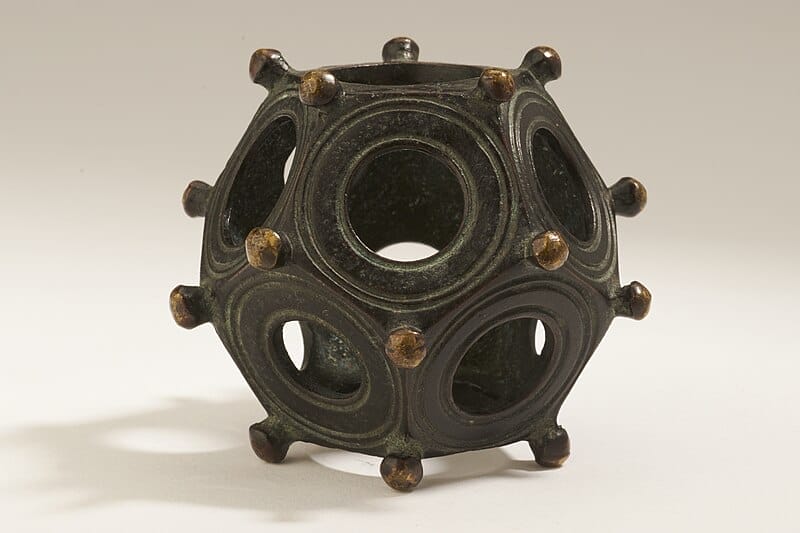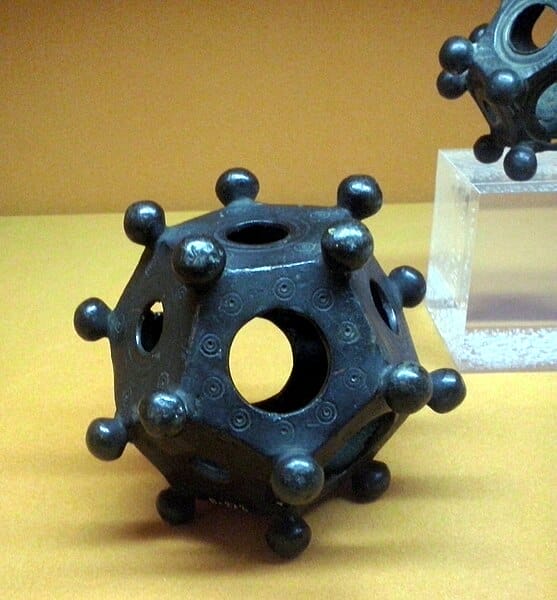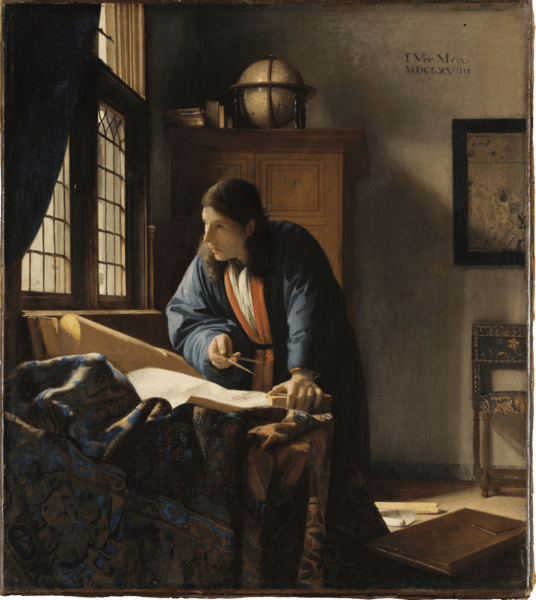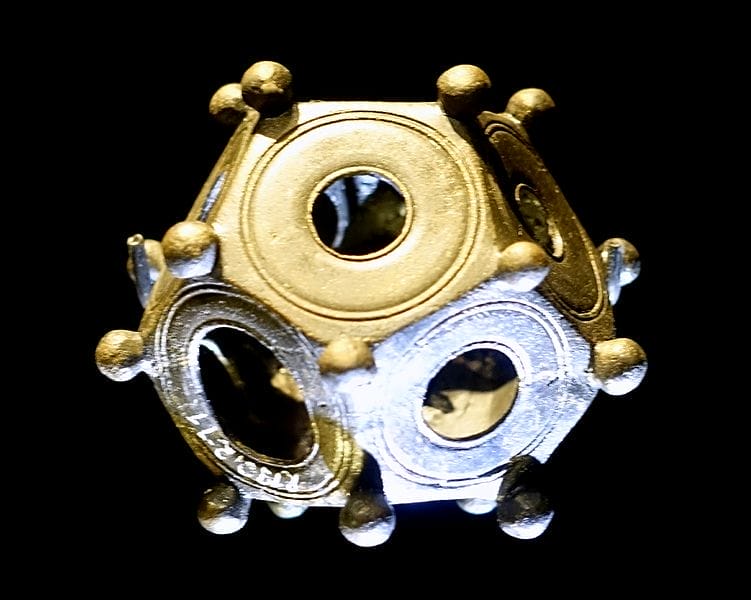
The Roman dodecahedron is a mysterious object that has puzzled historians and archaeologists for centuries. This small, hollow object is made of bronze and has twelve pentagonal faces, each with a circular hole in the center. It is believed to date back to the Roman Empire, although its exact purpose and function remain unknown.
Despite numerous theories and speculations, the true purpose of the Roman dodecahedron remains a mystery. Some experts believe that it was used as a measuring instrument, while others suggest it may have been a religious object or even a gaming device. One of the most intriguing aspects of the dodecahedron is that there are no known written records or descriptions of it from the time period in which it was created.
Besides its enigmatic nature, the Roman dodecahedron continues to fascinate researchers and historians. Its unique design and unknown purpose make it a valuable artifact that sheds light on the technological and cultural advancements of the ancient Roman Empire. As new discoveries are made and more information is uncovered, the mystery surrounding the Roman dodecahedron may one day be solved.
Archaeological Context
The object has been found in various locations across Europe, but the first Roman dodecahedron was discovered in 1739 in a field in the Netherlands. Since then, over one hundred examples have been found, mostly in Germany, France, and the Netherlands. They date back to the 2nd or 3rd century AD, during the Roman Empire.
These artifacts have been found across a wide geographical area that was once part of the Roman Empire, including regions in Europe and the Middle East. However, their precise origin and use remain uncertain due to the lack of associated contextual evidence, such as inscriptions or depictions in ancient art.
Several hypotheses have been proposed regarding the function of the Roman dodecahedron based on their context and features. Some researchers believe that they were purely decorative or ceremonial objects, perhaps used as status symbols or religious artifacts. Others suggest that they might have had practical functions, such as candle holders, dice for gaming, surveying instruments, or even instruments for measuring distances or angles.
Initial Findings
The lack of consistent archaeological context for these objects makes it challenging to determine their exact purpose, which is why the initial findings of the Roman dodecahedron were inconclusive. Furthermore, the fact that they vary in size and design adds another layer of complexity to the puzzle. Some dodecahedra are intricately decorated, while others are relatively plain, suggesting that they may have served different functions or held varying cultural significance. Archaeologists were unsure whether it was a religious object, a tool, or a toy. Some believed it was a measuring device used for surveying land or calculating distances. Others thought it was a candlestick holder or a decorative item.

However, as more examples were found, patterns began to emerge. The Roman dodecahedron is always made of bronze or stone and always has twelve pentagonal faces with circular holes. The holes are all of different sizes and are not perfectly centered. The object is hollow, and some have small knobs or projections on the edges of the faces.
On the other hand, the function of the Roman dodecahedron remains a mystery. There is a high probability that it had multiple uses or its purpose was lost over time. Whatever its original function, the Roman dodecahedron remains a fascinating artifact of the ancient world.
Physical Description
The Roman dodecahedron is a small, hollow object made of bronze or stone that measures between 4 and 11 centimeters in diameter. It is characterized by its distinctive shape, which resembles a regular dodecahedron, consisting of 12 flat pentagonal faces, each of which is decorated with a circular hole in the center. The holes vary in size and are surrounded by concentric circles. The object has a total of 20 vertices, with three faces meeting at each vertex. The thickness of the metal used to create them also varies, but it is generally relatively thin, contributing to their lightweight nature.
In terms of craftsmanship, Roman dodecahedra exhibit a high level of skill and precision. The faces are usually evenly formed, and the edges are often well-defined. Some examples feature intricate decorations, such as engraved patterns or raised knobs, while others are relatively plain.
Despite their uniform geometric shape, Roman dodecahedra can differ significantly in terms of design details. Some may have protruding knobs or studs at the vertices of the pentagonal faces, while others may feature additional perforations or decorative elements. The physical appearance of Roman dodecahedra suggests that they were carefully crafted objects with some level of significance or purpose.
Geometric Structure
The geometric structure of the Roman dodecahedron is quite fascinating. It has a highly symmetrical geometric structure, with each pentagonal face being identical to the others. The object has a regular dodecahedron shape, which means that all of its faces are congruent regular pentagons, and all of its vertices are equidistant from the center.
One notable feature of the Roman dodecahedron is the presence of a circular hole in the center of each pentagonal face. These holes are relatively small compared to the overall size of the object and are typically positioned symmetrically within each face. The purpose of these holes remains a subject of speculation, adding to the mystery surrounding the artifact.

Material and Craftsmanship
The Roman dodecahedron was crafted with great skill and precision. The object is made of bronze or stone, and its surface is often decorated with intricate patterns and designs. Bronze is an alloy typically composed of copper and tin, though other metals such as lead or zinc may also be present in small amounts depending on the specific composition. This alloy was widely used by ancient civilizations due to its durability, malleability, and resistance to corrosion. The holes in the faces of the dodecahedron were likely drilled using a lathe or similar tool, indicating a high level of craftsmanship.
Crafting a Roman dodecahedron would have required skilled people who were proficient in techniques such as casting, forging, and finishing. The process likely involved several steps, beginning with the preparation of the metal alloy. Once the bronze was melted and properly mixed, it could be poured into a mold to create the basic dodecahedral shape.
After the initial casting, the artifact would undergo further refinement to achieve its final form. This may have included polishing the surfaces to achieve a smooth texture, as well as adding decorative elements such as engraved patterns or raised knobs. The circular holes in the center of each pentagonal face would also be carefully drilled or punched to ensure consistency and precision.
Religious Significance
The Roman dodecahedron has long been a subject of mystery and speculation. Some historians believe that the object had religious significance and was used in ancient Roman religious ceremonies. The dodecahedron’s geometric shape has been associated with the universe and the divine, leading some to believe that it was used as a tool for divination or even as a symbol of the gods themselves.
For example, it has been proposed that they could have been used as tools in divination or religious ceremonies. The geometric form of the dodecahedron, with its twelve faces, could have been associated with symbolic meanings related to cosmic or spiritual concepts. Another hypothesis suggests that Roman dodecahedra may have been used as offerings or votive objects in religious rituals. Their precise geometric structure and craftsmanship may have been seen as representing perfection or divine order, making them suitable for use in religious contexts.
Some researchers have suggested connections between the Roman dodecahedron and ancient mystery cults or esoteric practices. These cults often employed symbols and objects with hidden meanings in their rituals, and the dodecahedron’s geometric complexity could have held significance within such traditions.
Practical Uses
Besides its potential religious significance, many historians believe that the Roman dodecahedron also had practical uses. Some have suggested that it was used as a measuring instrument, possibly for determining the weight or volume of small objects. Others have speculated that it was used as a tool for making jewelry or other small metal objects.
Astronomical Instrument
One of the most intriguing theories about the Roman dodecahedron is that it was used as an astronomical instrument. Some historians have suggested that the object was used to track the movements of the planets and stars, possibly even to predict eclipses. The dodecahedron’s twelve faces could have been used to represent the twelve signs of the zodiac, making it a valuable tool for astrological calculations.
Overall, the true purpose of the Roman dodecahedron still remains a mystery. While there are many theories about its function, there is no definitive evidence to support any one theory. Nevertheless, the object remains a fascinating artifact from ancient Rome, and its unique geometric shape continues to capture the imagination of historians and scholars alike.
Cultural Impact
The Roman dodecahedron has inspired artists throughout history. Its unique shape and mysterious purpose have captured the imagination of many. The dodecahedron has been depicted in various forms of art, including paintings, sculptures, and even jewelry.

One notable example is the painting “The Geographer” by Johannes Vermeer, which features a dodecahedron prominently displayed on a table. The painting has been interpreted in many ways, with some suggesting that the dodecahedron represents the pursuit of knowledge and understanding.
Modern Replicas
In recent years, there has been a growing interest in the Roman dodecahedron, with many people creating modern replicas. These replicas are often used as decorative objects or as educational tools to teach people about Roman history and culture. Some replicas are made from metal, while others are made from plastic or other materials. They come in a range of sizes, from small handheld objects to larger display pieces.
Modern replicas of Roman dodecahedra have been created by artisans, historians, and enthusiasts interested in exploring the form and potential function of these enigmatic artifacts. By creating accurate replicas, educators can provide hands-on experiences for students and visitors, allowing them to examine the geometric structure and craftsmanship of these artifacts up close. Above that, replicas may also be accompanied by interpretive materials explaining the historical context and various theories regarding their function.
These replicas are also popular among collectors and enthusiasts of historical artifacts. Whether faithfully reproduced or creatively reimagined, these replicas can be displayed as decorative items in homes, offices, or personal collections. They offer a tangible connection to the ancient world and evoke curiosity and fascination with their mysterious origins and potential functions.
Regardless of what is known about it, the cultural impact of the Roman dodecahedron is significant, with its unique shape and mysterious purpose continuing to inspire artists and intrigue historians to this day.
Academic Debates
Scholars have long debated the purpose and significance of the Roman dodecahedron. Some experts argue that it was used as a measuring instrument for astronomical calculations, while others believe it was used for religious purposes or as a gaming piece. Despite numerous studies, no consensus has been reached on its true function.
One theory suggests that the Roman dodecahedron was used as a tool for measuring distances on maps or for determining the volume of containers. However, others dispute this idea, citing the lack of evidence for such use and the complexity of the object’s design.
One of the primary debates surrounding the Roman dodecahedron revolves around its function. Scholars have proposed various hypotheses, including its use as a measuring instrument, a candle holder, a gaming die, a religious or ritual object, or even an astronomical tool. Each theory has its proponents and detractors, and the lack of direct evidence or written records detailing the purpose of these artifacts adds to the uncertainty.
Another topic of debate is the geographical distribution of Roman dodecahedra. These artifacts have been found across a wide area that was once part of the Roman Empire, including regions in Europe and the Middle East. Some scholars argue that the widespread distribution suggests a common function or cultural significance, while others suggest that regional variations in design or context may indicate diverse uses.
The symbolic significance and meaning of the geometric form of the dodecahedron are topics of speculation and interpretation. Some suggest connections to mathematical or geometric principles, while others propose symbolic associations with religious or philosophical concepts. Deciphering the symbolic meaning of Roman dodecahedra requires interdisciplinary research drawing from archaeology, mathematics, philosophy, and other fields.
Recent Discoveries
In recent years, new discoveries have shed light on the Roman dodecahedron’s possible uses. In 2022, a team of archaeologists discovered a dodecahedron in a Roman military camp in Germany, suggesting that it may have been used by soldiers for gaming or divination.
Another recent discovery was made in 2023 when a dodecahedron was found buried with a Roman soldier in France. This discovery has led some experts to believe that the object may have had a religious or spiritual significance.
While these new findings have provided some insight into the Roman dodecahedron’s possible uses, the debate surrounding its true purpose continues. Further research and analysis will be necessary to fully understand this intriguing artifact from ancient Rome.

People Also Ask:
What is a Roman dodecahedron used for?
Speculative uses include as a survey instrument for estimating distances to (or sizes of) distant objects, though this is questioned as there are no markings to indicate that they would be a mathematical instrument.
How many Roman dodecahedrons have been found?
The dodecahedron (12-sided object) has been puzzling archaeologists since the 18th century when it was first discovered. Only 120 have been found across what was the Roman Empire, however, none have been found in Italy, Spain, Africa, or the Mediterranean.
How much is a Roman dodecahedron worth?
Roman dodecahedra continues to baffle after more than two-and-a-half centuries of study. Roman dodecahedron, £33,000 at Wilkinson’s.
What is the dodecahedron theory?
According to a recent theory, the Universe could be a dodecahedron. It is surprising that Plato used a dodecahedron as the quintessence to describe the cosmos! Plato (c. 427 BC – c. 347 BC) also stated that time had a beginning; it came together with the Universe in one instant of creation.
What did Plato say about the dodecahedron?
Earth was associated with the cube, air with the octahedron, water with the icosahedron, and fire with the tetrahedron. Of the fifth Platonic solid, the dodecahedron, Plato obscurely remarked, “…the god used [it] for arranging the constellations on the whole heaven.”
What is special about a dodecahedron?
While the regular dodecahedron shares many features with other Platonic solids, one unique property is that one can start at a corner of the surface and draw an infinite number of straight lines across the figure that return to the original point without crossing over any other corner.
Was the Roman dodecahedron found in England?
The Norton Disney History and Archeology Group was digging in a field near the village of Norton Disney in Lincolnshire, England, last summer when one of the volunteers stumbled upon a Roman dodecahedron. The unexpected discovery took place towards the end of a two-week search for ancient coins and broaches.
Hello, my name is Vladimir, and I am a part of the Roman-empire writing team.
I am a historian, and history is an integral part of my life.
To be honest, while I was in school, I didn’t like history so how did I end up studying it? Well, for that, I have to thank history-based strategy PC games. Thank you so much, Europa Universalis IV, and thank you, Medieval Total War.
Since games made me fall in love with history, I completed bachelor studies at Filozofski Fakultet Niš, a part of the University of Niš. My bachelor’s thesis was about Julis Caesar. Soon, I completed my master’s studies at the same university.
For years now, I have been working as a teacher in a local elementary school, but my passion for writing isn’t fulfilled, so I decided to pursue that ambition online. There were a few gigs, but most of them were not history-related.
Then I stumbled upon roman-empire.com, and now I am a part of something bigger. No, I am not a part of the ancient Roman Empire but of a creative writing team where I have the freedom to write about whatever I want. Yes, even about Star Wars. Stay tuned for that.
Anyway, I am better at writing about Rome than writing about me. But if you would like to contact me for any reason, you can do it at contact@roman-empire.net. Except for negative reviews, of course. 😀
Kind regards,
Vladimir
